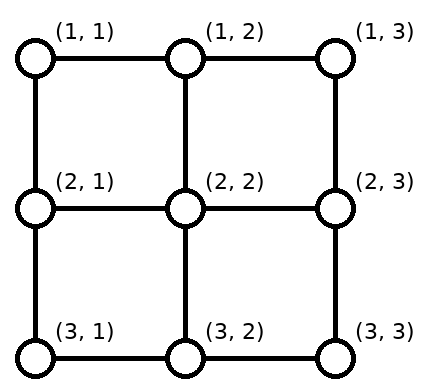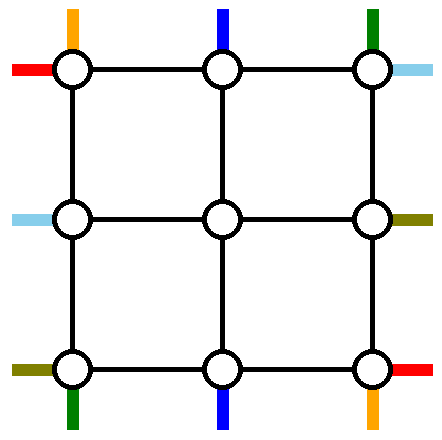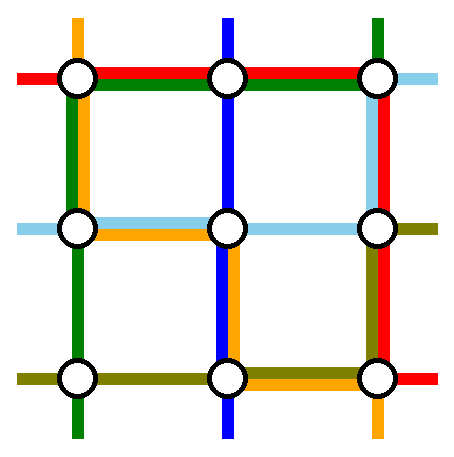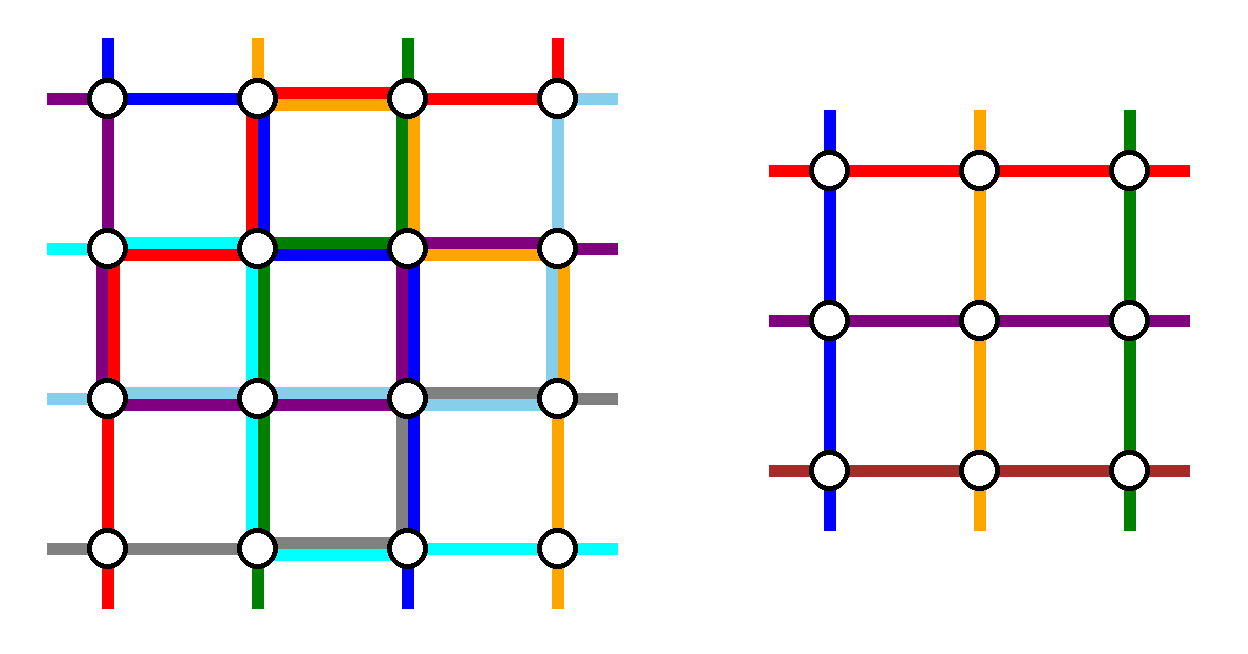CF1770H.Koxia, Mahiru and Winter Festival
普及/提高-
通过率:0%
AC君温馨提醒
该题目为【codeforces】题库的题目,您提交的代码将被提交至codeforces进行远程评测,并由ACGO抓取测评结果后进行展示。由于远程测评的测评机由其他平台提供,我们无法保证该服务的稳定性,若提交后无反应,请等待一段时间后再进行重试。
题目描述
Wow, what a big face!
Kagura Mahiru
Koxia and Mahiru are enjoying the Winter Festival. The streets of the Winter Festival can be represented as a n×n undirected grid graph. Formally, the set of vertices is {(i,j)∣1≤i,j≤n} and two vertices (i1,j1) and (i2,j2) are connected by an edge if and only if ∣i1−i2∣+∣j1−j2∣=1 .
 A network with size n=3 .Koxia and Mahiru are planning to visit The Winter Festival by traversing 2n routes. Although routes are not planned yet, the endpoints of the routes are already planned as follows:
A network with size n=3 .Koxia and Mahiru are planning to visit The Winter Festival by traversing 2n routes. Although routes are not planned yet, the endpoints of the routes are already planned as follows:
- In the i -th route, they want to start from vertex (1,i) and end at vertex (n,pi) , where p is a permutation of length n .
- In the (i+n) -th route, they want to start from vertex (i,1) and end at vertex (qi,n) , where q is a permutation of length n .
 A network with size n=3 , points to be connected are shown in the same color for p=[3,2,1] and q=[3,1,2] .Your task is to find a routing scheme — 2n paths where each path connects the specified endpoints. Let's define the congestion of an edge as the number of times it is used (both directions combined) in the routing scheme. In order to ensure that Koxia and Mahiru won't get too bored because of traversing repeated edges, please find a routing scheme that minimizes the maximum congestion among all edges.
A network with size n=3 , points to be connected are shown in the same color for p=[3,2,1] and q=[3,1,2] .Your task is to find a routing scheme — 2n paths where each path connects the specified endpoints. Let's define the congestion of an edge as the number of times it is used (both directions combined) in the routing scheme. In order to ensure that Koxia and Mahiru won't get too bored because of traversing repeated edges, please find a routing scheme that minimizes the maximum congestion among all edges.
 An example solution — the maximum congestion is 2 , which is optimal in this case.
An example solution — the maximum congestion is 2 , which is optimal in this case.
输入格式
The first line contains an integer n ( 2≤n≤200 ) — the size of the network.
The second line contains n integers p1,p2,…,pn ( 1≤pi≤n ).
The third line contains n integers q1,q2,…,qn ( 1≤qi≤n ).
It is guaranteed that both p and q are permutations of length n .
输出格式
Output 2n lines, each line describing a route.
The first n lines should describe the connections from top to bottom. The i -th line should describe the route starting at vertex (1,i) and ending at vertex (n,pi) .
The next n lines should describe the connections from left to right. The (i+n) -th line should describe the route starting at vertex (i,1) and ending at vertex (qi,n) .
Each line describing a route should start with an integer k ( 2≤k≤105 ) — the number of vertices the route passes, including the starting and ending vertices. Then output all the vertices on the route in order. In other words, if the route is (x1,y1)→(x2,y2)→⋯→(xk,yk) , then output k x1 y1 x2 y2…xk yk . Note that ∣xi−xi+1∣+∣yi−yi+1∣=1 should holds for 1≤i<k .
If there are multiple solutions that minimize the maximum congestion, you may output any.
输入输出样例
输入#1
3 3 2 1 3 1 2
输出#1
5 1 1 2 1 2 2 3 2 3 3 3 1 2 2 2 3 2 5 1 3 1 2 1 1 2 1 3 1 5 1 1 1 2 1 3 2 3 3 3 4 2 1 2 2 2 3 1 3 4 3 1 3 2 3 3 2 3
输入#2
4 3 4 2 1 2 4 1 3
输出#2
6 1 1 1 2 2 2 2 3 3 3 4 3 6 1 2 1 3 2 3 2 4 3 4 4 4 5 1 3 2 3 2 2 3 2 4 2 7 1 4 1 3 1 2 2 2 2 1 3 1 4 1 7 1 1 2 1 3 1 3 2 3 3 2 3 2 4 6 2 1 2 2 3 2 4 2 4 3 4 4 6 3 1 3 2 3 3 3 4 2 4 1 4 5 4 1 4 2 4 3 3 3 3 4
输入#3
3 1 2 3 1 2 3
输出#3
3 1 1 2 1 3 1 3 1 2 2 2 3 2 3 1 3 2 3 3 3 3 1 1 1 2 1 3 3 2 1 2 2 2 3 3 3 1 3 2 3 3
说明/提示
The first example corresponds to the figures in the problem statement.
The output for examples 2 and 3 respectively are visualized below:
 Sample output for examples 2 and 3 . Maximum congestions are 2 and 1 respectively.
Sample output for examples 2 and 3 . Maximum congestions are 2 and 1 respectively.